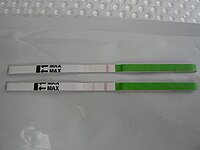
Photo from wikipedia
ABSTRACT Background One limitation of the use of 24-hour collection is impracticality. We analysed the performance of spot urine measurements to estimate 24-hour excretion in patients with kidney stones. Methods… Click to show full abstract
ABSTRACT Background One limitation of the use of 24-hour collection is impracticality. We analysed the performance of spot urine measurements to estimate 24-hour excretion in patients with kidney stones. Methods A total of 74 adult patients from two centres performed a 24-hour urine collection. A sample of the last micturition was sent for spot urine analysis. Twenty patients were asked to collect two additional spot urine samples, one before dinner and the other after dinner. Urinary concentrations of creatinine, calcium, oxalate, uric acid, citrate and magnesium were measured in the 24-hour and each of the spot urine samples. Four approaches were used to estimate 24-hour urinary excretion, multiplying the ratio of the spot urinary analyte to creatinine concentration by (i) measured 24-hour urinary creatinine excretion (Prediction 1), (ii) estimated 24-hour urinary creatinine excretion (Prediction 2), (iii) assumed 1-g 24-hour urinary creatinine excretion (Prediction 3) or (iv) assumed 1.5-g 24-hour urinary creatinine excretion (Prediction 4). For each parameter we computed Lin's concordance correlation coefficients (CCCs), Bland–Altman plots and 95% limits of agreement. Results The performance of estimates obtained with Prediction 1 and Prediction 2 was similar, except for citrate and uric acid, for which Prediction 2 performed worse. Both approaches performed moderately well: citrate CCC {0.82 [95% confidence interval (CI) 0.75–0.90]}, oxalate [0.66 (95% CI 0.55–0.78)], magnesium [0.66 (95% CI 0.54–0.77)], calcium [0.63 (95% CI 0.50–0.75)] and uric acid [0.52 (95% CI 0.36–0.68)]. The performance of Predictions 3 and 4 was worse. Conclusions Although spot urine samples may hold promise for clinical and population-based research, at present they have limited utility in clinical practice. Measuring or estimating 24-hour creatinine, rather than assuming a given creatinine excretion, will be necessary in future studies of spot urine samples.
Journal Title: Nephrology Dialysis Transplantation
Year Published: 2022
Link to full text (if available)
Share on Social Media: Sign Up to like & get
recommendations!